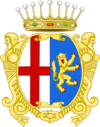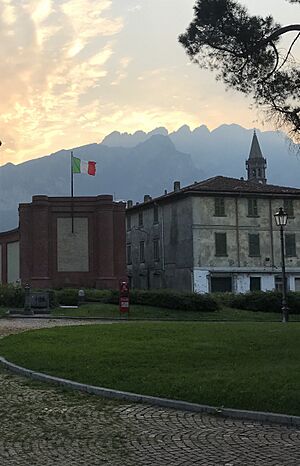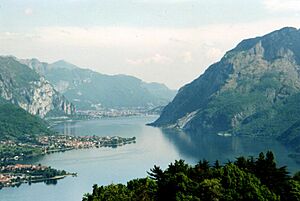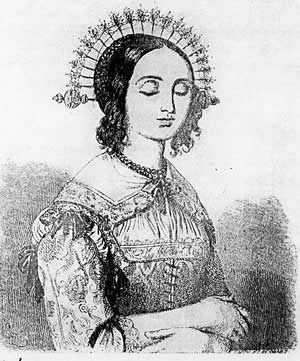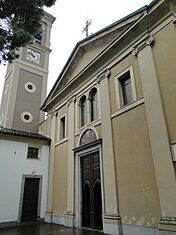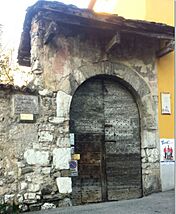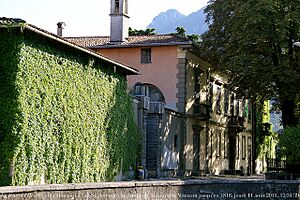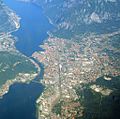Lecco facts for kids
Quick facts for kids
Lecco
Lècch (Lombard)
|
|||
|---|---|---|---|
| Città di Lecco | |||
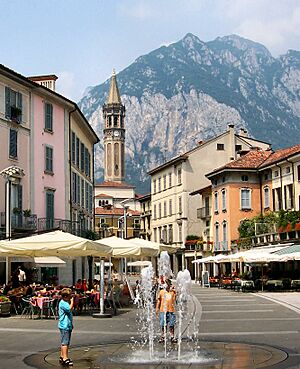
Piazza XX Settembre, in the centre of the town, and the San Martino mountain
|
|||
|
|||
| Country | Italy | ||
| Region | Lombardy | ||
| Province | Lecco (LC) | ||
| Frazioni | Acquate, Belledo, Bonacina, Castello, Chiuso, Germanedo, Laorca, Lecco, Maggianico, Malavedo, Olate, Pescarenico, Rancio, San Giovanni, Santo Stefano | ||
| Area | |||
| • Total | 45.14 km2 (17.43 sq mi) | ||
| Elevation | 214 m (702 ft) | ||
| Population
(December 31, 2021)
|
|||
| • Total | 46,831 | ||
| • Density | 1,037.46/km2 (2,687.0/sq mi) | ||
| Demonym(s) | Lecchesi | ||
| Time zone | UTC+1 (CET) | ||
| • Summer (DST) | UTC+2 (CEST) | ||
| Postal code |
23900
|
||
| Dialing code | 0341 | ||
| Patron saint | San Nicolò | ||
| Saint day | December 6 | ||
Lecco is a cool city in Lombardy, Northern Italy. It's about 50 kilometers (31 miles) north of Milan. This city sits right at the end of the southeastern part of Lake Como. The beautiful Bergamo Alps rise up to the north and east.
The lake here narrows into the River Adda. Because of this, several bridges were built to connect Lecco with other cities like Como and Milan. There are four bridges over the Adda River in Lecco, including the old Azzone Visconti Bridge from the 1300s.
Lecco was named the "Alpine Town of the Year" in 2013. It officially became a city on June 22, 1848. Later, in 1992, it became a province.
This city is famous because the writer Alessandro Manzoni set his well-known novel, The Betrothed, here. Lecco is also known as "the Iron City" because of its strong history in the steel industry.
Contents
- What's in a Name? Lecco's Origin
- Lecco's Journey Through Time
- Lecco's Weather and Winds
- Exploring Lecco's Geography
- Amazing Architecture in Lecco
- Fun Traditions and Folklore
- Discovering Manzoni's Lecco
- Getting Around Lecco
- Sports in Lecco
- Famous People from Lecco
- Lecco's Sister Cities
- Images for kids
- See also
What's in a Name? Lecco's Origin
The name Lecco might come from an old Celtic word. Words like "Lech" or "Loch" meant "lake" in Celtic. Around 1000 B.C., some Gauls and Celts came to this area for trade.
The Gauls called the place "Leucos." Later, the Romans changed it to "Leucum" when Julius Caesar was in charge around 200 B.C.
Lecco's Journey Through Time
Early Settlers: Celts and Romans
In 1988, archaeologists found an ancient village from the first Iron Age at Rocca di Chiuso. This shows that Celts lived here more than 400 years before other Celtic groups arrived.
In 2005, more digs found the oldest metal-making site in the whole Alpine region. This site was active between the 2nd and 1st centuries B.C.
The Middle Ages: A Strategic Hub
Lecco was a very important meeting point for several roads. These roads connected Lombardy with lands beyond the Alps. Because of this, the area saw many battles.
Around 960, Lecco came under the control of the Archbishop of Milan. For a long time, the name Lecco didn't just mean one town. It included the whole area between the lake and Valsassina. Different parts of Lecco worked together, each specializing in different jobs.
Becoming a Free City
In 1117, a ten-year war started between Milan (Lecco's ally) and many villages around Lake Como. Lecco's people joined the fight. In 1125, Como lost the battle.
Later, Lecco got caught up in fights between powerful Milanese families, the Visconti and Torriani. In 1296, Matthew I Visconti ordered the destruction of Lecco. But the city was rebuilt and taken back by Azzone Visconti. For a long time, Lecco was like a small, self-governing state with its own laws, even though it was part of the larger Duchy of Milan.
Spanish and Austrian Rule
After the Duchy of Milan fell, Lecco came under Spanish rule. Under Charles V, it became a military fort. During this time, Lecco suffered from terrible plagues and famines. The writer Alessandro Manzoni described these hard times in his novel, The Betrothed.
In 1714, the region of Lombardy, including Lecco, came under the control of the Austrians.
Modern Times: Growth and Independence
In 1784, Joseph II of Austria visited Lecco and decided to remove the city walls. When Napoleon came to power, Lecco became part of the Cisalpine Republic in 1797.
After Napoleon's defeat in 1814, the Austrian army took control again. Lecco became part of the province of Como until 1995. During this Austrian period, Lecco saw many improvements. There were new systems for government and industry grew, making life better for many people.
Lecco's Role in Italian Unification
In the 1800s, Lecco became a center for Italian culture. Writers and artists often met here. The city and its people played a big part in the Risorgimento, which was the movement to unite Italy.
In March 1848, when Milan rebelled against Austria, a priest in Lecco encouraged people to join the fight. Lecco was promoted to a city on June 22, 1848, because of its help in the fight for Italian unity.
In 1859, Lecco and Lombardy were taken over by the Kingdom of Sardinia. Lecco officially became a city again that same year. In 1923, Lecco grew bigger by adding nearby towns.
Lecco's Weather and Winds
Lecco has a humid subtropical climate. This means it has warm, wet summers and mild winters. Even though it's in a northern area, the mountains protect it, and the lake helps keep the weather mild.
Two important winds affect Lecco's climate:
- Tivano: This wind blows from the northeast in the mornings. If it's not blowing, it often means bad weather is coming.
- Breva: This wind blows from the south towards the lake. It usually means good weather.
| Climate data for Lecco | |||||||||||||
|---|---|---|---|---|---|---|---|---|---|---|---|---|---|
| Month | Jan | Feb | Mar | Apr | May | Jun | Jul | Aug | Sep | Oct | Nov | Dec | Year |
| Mean daily maximum °C (°F) | 2.1 (35.8) |
4.2 (39.6) |
8.2 (46.8) |
12.4 (54.3) |
16.2 (61.2) |
19.7 (67.5) |
22.2 (72.0) |
21.3 (70.3) |
18.4 (65.1) |
12.9 (55.2) |
7.2 (45.0) |
3.3 (37.9) |
12.3 (54.2) |
| Mean daily minimum °C (°F) | −1.3 (29.7) |
0.3 (32.5) |
3.3 (37.9) |
7.2 (45.0) |
11.1 (52.0) |
14.5 (58.1) |
16.8 (62.2) |
16.2 (61.2) |
13.6 (56.5) |
8.7 (47.7) |
3.6 (38.5) |
0 (32) |
7.8 (46.1) |
| Average rainfall mm (inches) | 60 (2.4) |
59 (2.3) |
72 (2.8) |
99 (3.9) |
112 (4.4) |
117 (4.6) |
92 (3.6) |
111 (4.4) |
105 (4.1) |
115 (4.5) |
107 (4.2) |
69 (2.7) |
1,118 (43.9) |
| Average relative humidity (%) | 75 | 75 | 68 | 71 | 69 | 67 | 67 | 68 | 71 | 75 | 78 | 79 | 72 |
| Source: climate-data.org and ilMeteo | |||||||||||||
Exploring Lecco's Geography
Lecco covers about 45.93 square kilometers (17.73 sq mi). It's in a wide valley with mountains to the east and Lake Lario to the west. This is where Lake Lario ends and the Adda River starts again, before flowing into Lake Garlate.
Three main streams flow through Lecco: the Gerenzone, the Calderone, and the Bione. The mountains around Lecco include:
- To the north: Monte Coltignone and San Martino.
- To the east: Mount Due Mani, Pizzo d'Erna, and Resegone.
- To the south: Magnodeno.
- To the west: Mount Barro.
The height of the land in Lecco varies a lot. It goes from 198 meters (650 ft) above sea level near the lake to 1875 meters (6,152 ft) at the top of Mount Resegone. This creates different types of landscapes and climates in the city.
The Resegone mountain is named for its many rocky peaks that look like a giant saw blade when seen from the town. Mount Barro, to the west, has a regional park to protect its plants and animals.
Amazing Architecture in Lecco
Religious Buildings
Lecco has many beautiful churches and basilicas.
- Minor Basilica of San Nicolò
- Santa Marta, Lecco
- San Giovanni Battista
- Santi Materno e Lucia
- San Francesco d'Assisi
- Santi Gervasio e Protasio
- Chiesa di Castello
- San Giuseppe
- Madonna della Rovinata
- Santuario di Nostra Signora della Vittoria
- Santa Maria Gloriosa
Other Important Buildings
You can also find many interesting non-religious buildings and monuments.
- Palazzo delle Paure
- Ponte Azzone Visconti (also called Ponte Vecchio)
- Villa Manzoni
- Memoriale ai Caduti (War Memorial)
- Statua del Manzoni (Manzoni Statue)
- Monuments to Mario Cermenati and Giuseppe Garibaldi
Fun Traditions and Folklore
Traditional Dresses
The traditional dress for women in Lecco is linked to Lucia from The Betrothed. It features a special headpiece with silver pins called "guazze."
Manzoni Procession
This parade features floats inspired by scenes from Alessandro Manzoni's novel. It's not held every year, but it's a cherished tradition. The first one was in 1923.
Carnevalone of Lecco
Every February, Lecco celebrates its "Carnevalone." This carnival tradition started in 1884. The Mayor gives the city keys to King Resegone and Queen Grigna to start the festivities. The main event is a parade of floats on Fat Saturday.
ResegUp Race
This is a trail running race that happens in early June. It started in 2010. Runners follow old paths from the city center up to the top of Mount Resegone.
Batej Regatta
This traditional boat race takes place on the Adda River in July. Eight colorful boats, each representing a different district, compete. Before the main race, there's a race with "Lucie" boats, which are traditional lake boats.
Scigamatt Race
This obstacle course race happens in the Acquate district. It remembers June 6, 1859, when people from Acquate cheered General Giuseppe Garibaldi with songs.
Discovering Manzoni's Lecco
Many places in Lecco inspired Alessandro Manzoni's novel, The Betrothed. You can visit these spots to imagine the story coming to life. Some are historical, while others are known through local stories.
Fra Cristoforo's Convent
This church in Pescarenico is now dedicated to Saints Lucia and Materno. In The Betrothed, Manzoni wrote about this as the home of Fra Cristoforo.
Lucia Mondella's House
People believe Lucia's house is at Via Caldone 19 in the Olate district. It's a typical old Lecco house with a decorated entrance and a rustic courtyard. It's a private home, so you can't go inside. Another house in Acquate is also said to be Lucia's.
Tabernacolo dei Bravi
This small chapel is on Via Tonio and Gervaso. It's known as the place where Don Abbondio was stopped by Don Rodrigo's men in the novel.
Villa Manzoni
This beautiful neoclassical villa was Alessandro Manzoni's family home. It's now the Civic Museum of Manzoni and an art gallery. Manzoni lived here as a child and young adult. The amazing descriptions of the landscape in his novel were inspired by the views from this villa.
Getting Around Lecco
Buses
Lecco has a good bus system. Local buses are managed by Linee Lecco. You can also find buses for longer trips to other cities like Como.
Trains
Lecco has two train stations: Lecco (the main one) and Lecco Maggianico. Trains are mostly run by Trenord.
Boats
In the past, there were more boat services on Lake Como from Lecco. Today, the town's pier is mainly used for seasonal trips, fun boat rides, and private charters.
Cable Car
An aerial cable car connects Versasio to Piani d'Erna. It opened in 1965 and offers great views!
Sports in Lecco
Lecco has a football (soccer) team called Calcio Lecco 1912. They were promoted to Serie B in 2023. They have a strong rivalry with the team from Como, known as the "Derby del Lario."
The main sports stadium in the city is the Rigamonti-Ceppi Stadium. It was built in 1922 and can hold almost 5,000 people. It's named after football player Mario Rigamonti and former team president Mario Ceppi.
Lecco has also been a finish line for the famous Giro di Lombardia cycling race many times.
Famous People from Lecco
Many notable people have come from Lecco:
- Alessandro Manzoni (1785–1873): A famous poet and novelist, author of I promessi sposi.
- Antonio Stoppani (1824–1891): A geologist and palaeontologist.
- Antonio Ghislanzoni (1824–1893): A journalist, poet, and novelist who wrote for famous operas like Aida.
- Carlo Mauri (1930–1982): A climber and explorer.
- Antonio Rossi (born 1968): A canoeist and five-time Olympic medalist.
- Marco Bonanomi (born 1985): A racing car driver.
- Manuel Locatelli (born 1998): A footballer who plays for Juventus and Italy.
- Baby Gang (born 2001): A popular Italian rapper.
Lecco's Sister Cities
Lecco is twinned with several cities around the world. This means they have special friendly relationships and often share cultural exchanges.
 Mâcon, France (since 1973)
Mâcon, France (since 1973) Overijse, Belgium (since 1981)
Overijse, Belgium (since 1981) Igualada, Spain (since 1990)
Igualada, Spain (since 1990) Szombathely, Hungary (since 1995)
Szombathely, Hungary (since 1995) Mytishchi, Russia (since 2005)
Mytishchi, Russia (since 2005)
Images for kids
See also
 In Spanish: Lecco para niños
In Spanish: Lecco para niños



